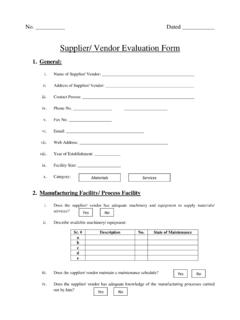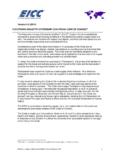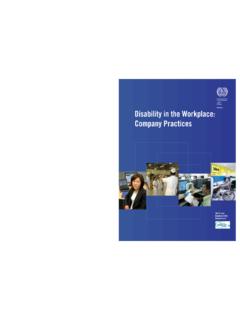Transcription of Minimum Standards in Shelter, Settlement and non …
1 Minimum Standards in Shelter, Settlement and non-Food ItemsHumanitarian Charter and Minimum Standards in Humanitarian Response240 How to use this chapterThis chapter is divided into two main sections:Shelter and settlementnon-food items: clothing, bedding and household itemsBoth sections provide general Standards for use in any of several response scenarios for displaced and non-displaced populations, including temporary or transitional individual household shelter on original sites, or the return to repaired dwellings; temporary accommodation with host families; and/or temporary communal Settlement comprising planned or self-settled camps, collective centres, transit or return centres The Protection Principles and Core Standards must be used consistently with this chapter Although primarily intended to inform humanitarian response to a disaster, the Minimum Standards may also be considered during disaster preparedness and the transition to recovery and recon-struction activities Each section contains the following: Minimum Standards : These are qualitative in nature and specify the Minimum levels to be attained in humanitarian response regarding the provision of shelter Key actions.
2 These are suggested activities and inputs to help meet the Standards Key indicators: These are signals that show whether a standard has been attained They provide a way of measuring and communicating the processes and results of key actions; they relate to the Minimum standard, not to the key action Guidance notes: These include specific points to consider when applying the Minimum stan-dards, key actions and key indicators in different situations They provide guidance on tackling practical difficulties, benchmarks or advice on priority issues They may also include critical issues relating to the Standards , actions or indicators, and describe dilemmas, controversies or gaps in current knowledge If required key actions and indicators cannot be met.
3 The resulting adverse implications on the affected population should be appraised and appropriate mitigating actions taken A needs assessment checklist is provided to inform the application of the Minimum Standards in both defining and monitoring response activities, and a list of references and further reading, including a selection of practical how to guidance resources, is also included Minimum Standards in Shelter, Settlement and non-food Items241 ContentsIntroduction 2431 Shelter and Settlement 2492 n on-food items: clothing, bedding and household items 268 Appendix 1.
4 Shelter, Settlement and non-food items assessment checklist 278 References and further reading 284 Humanitarian Charter and Minimum Standards in Humanitarian Response242 Protection PrinciplesStandard 5 Environmental impactStandard 4 ConstructionStandard 3 Covered living spaceStandard 2 Settlement planningStandard 1 Strategic planningShelter and settlementHumanitarian CharterStandard 5 Tools and fixingsStandard 4 Stoves, fuel and lightingStandard 3 Cooking and eating utensilsStandard 2 Clothing and beddingStandard 1 Individual, general household and shelter support items Non-food itemsCore StandardsShelter, Settlement and non-food itemsAppendix 1: Shelter, Settlement and non-food items assessment checklistReferences and further readingMinimum Standards in Shelter, Settlement and non-food Items243 IntroductionLinks to the Humanitarian Charter and international lawThe Minimum Standards for shelter, Settlement and non-food items are a practical expression of the shared beliefs and commitments of humanitarian agencies and the common principles, rights and duties governing humanitarian action that are set out in the Humanitarian Charter.
5 Founded on the principle of humanity, and reflected in international law, these principles include the right to life and dignity, the right to protection and security and the right to receive humanitarian assis-tance on the basis of need. A list of key legal and policy docu ments that inform the Humanitarian Charter is available for reference in Annex 1 (see page 356), with explanatory comments for humanitarian workers. In humanitarian action, shelter, Settlement and associated non-food items are familiar terms that fall within the scope of the right to adequate housing, which is enshrined in human rights has the right to adequate housing. This right is recognised in key inter-national legal instruments (see References and further reading: International legal instruments).
6 This includes the right to live in security, peace and dignity, with security of tenure, as well as protection from forced eviction and the right to resti-tution. These instruments define adequate housing as ensuring: sufficient space and protection from cold, damp, heat, rain, wind or other threats to health, including structural hazards and disease vectors the availability of services, facilities, materials and infrastructure affordability, habitability, accessibility, location and cultural appropriateness sustainable access to natural and common resources; safe drinking water; energy for cooking, heating and lighting; sanitation and washing facilities; means of food storage; refuse disposal; site drainage.
7 And emergency services the appropriate siting of settlements and housing to provide safe access to healthcare services, schools, childcare centres and other social facilities and to livelihood opportunities that building materials and policies relating to housing construction appropri-ately enable the expression of cultural identity and diversity of Charter and Minimum Standards in Humanitarian Response244 The Minimum Standards in this chapter are not a complete expression of the right to adequate housing as defined by the relevant international legal instruments. Rather, the Minimum Standards reflect the core content of the right to adequate housing and contribute to the progressive realisation of this importance of shelter, Settlement and non-food items in disastersShelter is a critical determinant for survival in the initial stages of a disaster.
8 Beyond survival, shelter is necessary to provide security, personal safety and protection from the climate and to promote resistance to ill health and disease. It is also important for human dignity, to sustain family and community life and to enable affected populations to recover from the impact of disaster. Shelter and associ-ated Settlement and non-food item responses should support existing coping strategies and promote self-sufficiency and self-management by those affected by the disaster. Local skills and resources should be maximised where this does not result in adverse effects on the affected population or local economy. Any response should take into account known disaster risks and minimise the long-term adverse impact on the natural environment, while maximising opportunities for the affected population to maintain or establish livelihood support comfort, protection from the effects of the climate and personal safety and dignity are achieved by meeting a combination of needs at the level of the individuals themselves, the covered space they inhabit and the location in which their covered area is situated.
9 Similarly, meeting these needs requires an appro-priate combination of the means to prepare, cook and eat food; clothing and bedding; an adequate covered area or shelter; a means of space heating and ventilation as required; and access to essential shelter, Settlement and non-food item needs of populations affected by a disaster are determined by the type and scale of the disaster and the extent to which the population is displaced. The response will also be informed by the ability and desire of displaced populations to return to the site of their original dwelling and to start the recovery process: where they are unable or unwilling to return, they will require temporary or transitional shelter and Settlement solu-tions (see the diagram opposite).
10 The local context of the disaster will inform the response, including whether the affected area is rural or urban; the local climatic and environmental conditions; the political and security situation; and the ability of the affected population to contribute to meeting their shelter needs. Minimum Standards in Shelter, Settlement and non-food Items245 Shelter and Settlement options and response scenariosPRE-DISASTER SETTLED POPULATIONT emporary or permanent shelterSettlement typologiesHouse owner occupierApartment owner occupierHouse tenantApartment tenantLand tenantOccupancy with no legal statusDisasterSETTLEMENT T yPOLOGIESSETTLEMENT T yPOLOGIESDURABLE SOLUTIONSR econstructionResettlementReintegrationPO ST-DISASTER NON-DISPLACED POPULATIONT emporary or transitional shelter.












